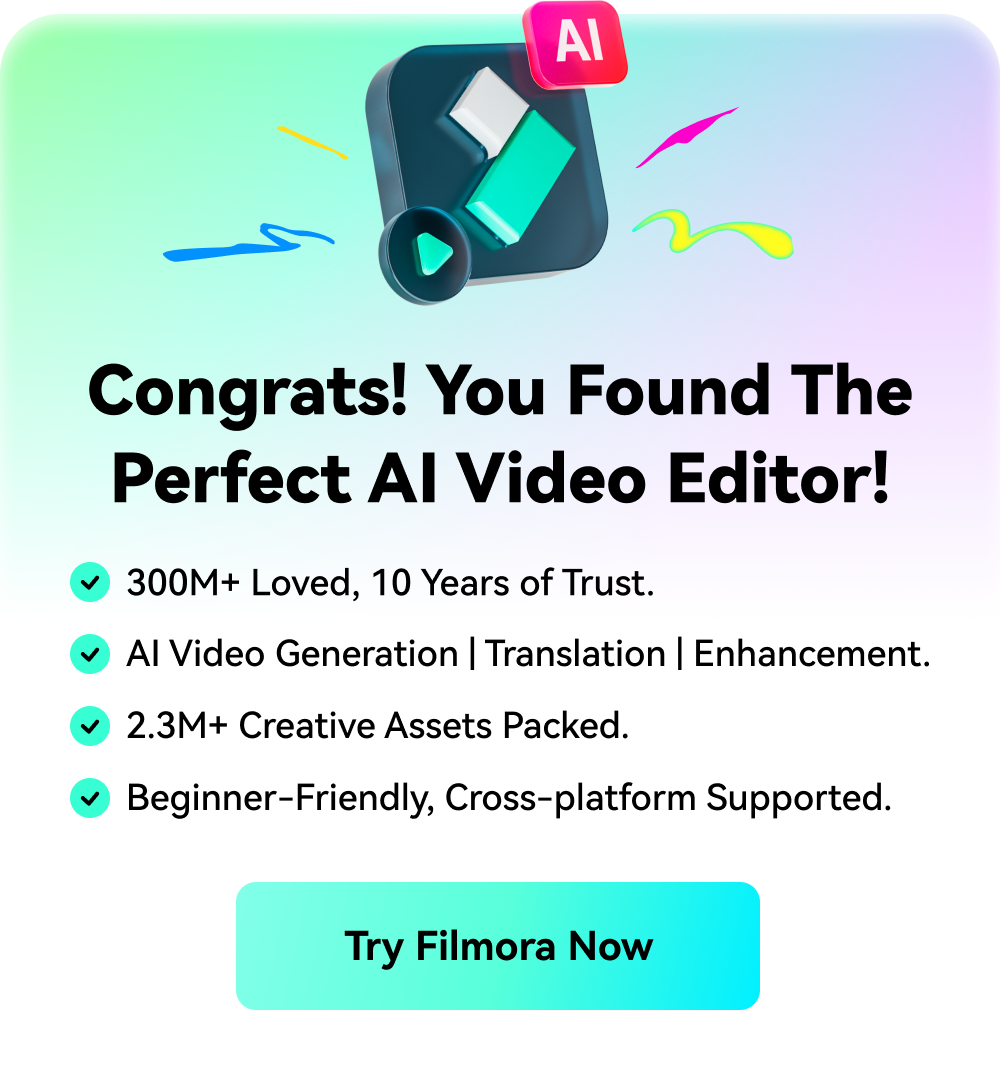Introduction
OpenAI has unveiled its newest innovative technology, Sora. So far, this generative AI model that converts text to video is waiting for its launch. It claims to change the game of making videos by turning prompts into visuals. That's why it is one of the most talked-about AI tools of the year. Yet, as of March 2024, this model isn't publicly accessible. With its innovative technology, Sora is a giant leap forward in artificial intelligence. It has opened new possibilities for storytelling, narrative, and artistic expression.
Let's learn more about Sora to find out what it is, its operation, possible applications, and plans.
In this article
Complentment to Sora to turn your creativity into real scenes and edit them effortlessly with AI.

Part 1: What Is OpenAI Sora?
The OpenAI Sora platform converts text instructions to videos. It lets you transform static text into interactive video. It has introduced a new age of content production with machine learning algorithms.
Even though Sora is still in its infancy, the AI model has been rather popular on social media. Its demo videos seem to have been produced by actors and filmmakers.
Of course, it isn't the very first AI video model. But Sora showed remarkable reliability and realistic accuracy. The video outputs seem promising. The videos published on Sora's official X or TikTok were created by OpenAI employees.
There has been no announcement on the model's release date or restrictions on its use. We can create a review based on the information and demos available on its website.
Prompt: A flock of paper airplanes flutters through a dense jungle, weaving around trees as if they were migrating birds.
Source: OpenAI
Part 2: A Closer Look at the Work Mechanics Behind Sora
OpenAI's revolutionary model, Sora, employs a multi-pronged strategy that combines many techniques. For example, you can check a simple demo video created using simple prompts. The prompt asked Sora to create a video showing a stylish lady walking along a Tokyo street. Neon signs and other flashing commercials light up the street.
Prompt: A stylish woman walks down a Tokyo street filled with warm glowing neon and animated city signage. She wears a black leather jacket, a long red dress, and black boots, and carries a black purse. She wears sunglasses and red lipstick. She walks confidently and casually. The street is damp and reflective, creating a mirror effect of the colorful lights. Many pedestrians walk about.
Source: OpenAI
Sora uses a database of video clips to decipher the instructions. After that, it creates a motion simulation of the real world.
Sora can also deduce the user's preferred video aesthetic and tone. Check this video created with a simple prompt - cinematic style, shot on 35mm film, vivid colors. As you can see, the color and camera angle can be changed based on the instructions.
Prompt: A movie trailer featuring the adventures of the 30 year old space man wearing a red wool knitted motorcycle helmet, blue sky, salt desert, cinematic style, shot on 35mm film, vivid colors.
Source: OpenAI
Sora can create videos of different resolutions. Moreover, it can handle various genres. It includes science fiction, horror, humor, and more. It does all these tasks with its robust algorithms and NLP. However, before we discuss the concept of NLP, we must first understand neutral networks.
What Is a Neural Network?
It is a program that uses NLP to understand written instructions. It helps AI transform prompts into amazing visuals as the user requests.
Sora relies on a deep neural network, which is one kind of machine learning model. It can learn from data and carry out complicated tasks. Sora depends on a vast library of video clips. Its video library includes many different styles, genres, and subjects.
Sora examines the text and uses keywords like topic, action, place, time, and emotion. It analyzes these keywords as input. After that, it searches the dataset for the best videos that fit the criteria and combines them to make a video.
Another method that Sora employs is style transfer. It changes the video's look and feel based on the user's choices.
Prompt: The camera rotates around a large stack of vintage televisions all showing different programs — 1950s sci-fi movies, horror movies, news, static, a 1970s sitcom, etc, set inside a large New York museum gallery.
Source: OpenAI
Part 3: What Are the Applications of Sora?
When it comes to AI and video editing, Sora seems far ahead. Its impressive grasp of physical motion, the sense of sight, and language are worth noting. Above all, it represents how AI can revolutionize content creation for industries. It includes education, visual art, communication, and entertainment.
1) Entertainment
In the entertainment business, Sora is revolutionizing everything! Be it improving visual effects or automating production processes!
- Film Production: Producers can save time and money on pre-production using Sora. It streamlines the scene visualization and storyboarding process.
- Animation: Animation companies can use Sora to improve the quality of their movies. It can help them generate decent visual effects and realistic character animations.
- VR and AR: Sora has an excellent ability to generate immersive graphics. That makes it helpful in developing VR/AR experiences.
2) Education
Sora revolutionizes the way teachers present study material. It also allows students of various backgrounds to participate in more dynamic learning.
- Interactive Learning: Sora promotes interactive learning and provides students with various learning styles. Teachers can use Sora to create lessons, simulations, and even games. Such informative videos are beneficial in online classes and virtual classrooms.
- Visual Demonstrations: Sora assists teachers in simplifying complex ideas via visuals. It can help them create engaging educational videos.
3) Marketing
Marketers can use Sora to provide tailored content that increases brand recognition. A company regularly creating videos can get a boost in conversion rates.
- Custom Ads: Brands can use Sora to make video ads specific to each consumer's tastes. It increases the relevancy of their commercials. Sora allows marketers to create engaging product tutorials, highlighting its features and USPs.
- Customized Content: Companies can use Sora to make engaging brand stories. Visually stunning films help build brand loyalty and identity.
Part 4: What Are the Top Challenges and Limitations of Using Sora?
OpenAI has pointed out some issues with the current Sora version. Sora might need an implicit grasp of physics and complex words. So, there may be instances when Sora disregards "real-world" physical norms. The model's inability to understand the concept of cause and effect is one example of this.
This demo video shows five gray wolf pups. The video doesn't appear natural if we look closely. It seems like all the pups appear out of nowhere.
Prompt: Five gray wolf pups frolicking and chasing each other around a remote gravel road, surrounded by grass. The pups run and leap, chasing each other, and nipping at each other, playing.
Source: OpenAI
Here are a few more limitations of Sora:
- Visual Synthesis's Complexity: Sora makes visuals out of verbal instructions. But, it may not be able to synthesize abstract or complicated concepts correctly. AI must progress further to overcome this obstacle.
- Data Dependency: Sora's performance depends on many things. But, the variety and quality of the training material it gets are the significant factors here. Using incomplete or biased datasets might lead to unsuitable results. Sora should gather different and accurate datasets that cover various visual ideas.
- Customization: Sora's visual content generation capabilities are excellent. But, it can be challenging to fine-tune and personalize the outputs to meet individual needs. Sora should focus more on the style, composition, and story aspects. That can make the program more valuable and applicable in different sectors.
- Legal Aspects: Like any AI system, Sora brings significant ethical and legal questions. It includes some apparent concerns related to data privacy and copyrights.
- Resource Limitations: Users with limited hardware or bandwidth may find trouble using Sora. It requires considerable computing resources and a fast internet connection. Improving the efficiency of Sora's algorithms can solve this issue.
Of course, OpenAI only provides high-quality demos on its website. But right now, it's hard to tell how trustworthy Sora is. Thus, we must wait until the tool is accessible before answering this question.
Part 5: What Are the Top Alternatives to Sora?
Sora isn't the only widespread option for making videos from text. Well, there are many other prominent alternatives to it. Among them are:
1) Runway Gen-2
The AI-powered Runway Gen-2 platform offers many creative tools. It comes with features like text-to-video, picture alteration, and generative design. Runway Gen-2 provides a superb alternative to Sora.
Content creators can enjoy the friendly interface and robust algorithms of this platform. Runway Gen-2's text-to-video feature allows users to create videos from written prompts.
You can check this demo showing a penthouse in New York City. It highlights Runway Gen-2's capacity. Its AI-driven program can bring ideas to life by generating animated scenarios.

2) Pika
Are you interested in art, design, or storytelling? Pika is an adaptable AI platform that can let you express yourself and try new things. It allows users to create appealing videos from written suggestions. The process of video-making is both smooth and easy.
Pika allows users to experiment with ideas and turn them into visual stories. Below is an example that shows how it can animate scenes using descriptive language.

3) Make-A-Video
You can use Make-a-Video to create stunning videos with ease. It is the best alternative to Sora as it offers various video-making tools. Users can describe scenes or events using Make-a-Video's text-to-video synthesis tool. After that, the app will create video sequences that match those descriptions. Making videos has never been easier than with Make-a-Video. Anyone from content producers to marketers can use it.
Check out this demo that shows how Make-a-Video can generate animated scenes from text.

Conclusion
Without a doubt, Sora's innovative text-to-video synthesis technology has changed video production work. It has opened new avenues for content development. Its fresh perspective has broadened the creative horizons of many.
However, this platform is not yet available to the public. Don't worry! Filmora provides a suitable substitute for Sora's technology. You can continue your work with Filmora's Text-to-Video feature. It provides an excellent option to create interactive video content using written instructions. Filmora offers a full suite of tools for visualizing ideas. It includes precise editing tools, editable templates, and special effects.



